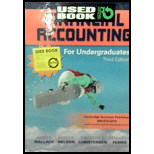
a.
Calculate the Corporation PK’s
a.
Explanation of Solution
Current ratio: The financial ratio which evaluates the ability of a company to pay off the debt obligations which mature within one year or within completion of operating cycle is referred to as current ratio. This ratio assesses the liquidity of a company.
Current ratio is calculated by using the formula:
Calculate the current ratio for year 1:
Current assets for year 1 is $1,055,776,000
Current liabilities for year 2 is $358,729,000
Hence, the current ratio for Year 1 is 2.94.
Calculate the current ratio for year 2:
Current assets for year 2 is $1,056,443,000
Current liabilities for year 2 are $468,254,000
Hence, the current ratio for Year 2 is 2.26.
Calculate the current ratio for year 3.
Current assets for year 3 is $1,018,354,000
Current liabilities for year 3 are $504,444,000
Hence, the current ratio for Year 2 is 2.02.
b.
Calculate operating cash flow to current liabilities ratio for Year 1, Year 2 and Year 3.
b.
Explanation of Solution
Operating cash flow to current liabilities ratio measures the capability of the company to pay it current liabilities. In this, higher the ratio shows that the company has sufficient cash flow to pay its debts.
Formula to calculate the operating cash flow to current liabilities ratio is:
Calculate the operating cash flow to current liabilities ratio for Year 1.
Operating cash flow from operating activities for Year 1 is $235,186,000
Average current liabilities for Year 1 is $352,161,500 (1)
Working note:
Calculate the average current liabilities for Year 1.
Thus, the operating cash flow to current liabilities ratio is 0.67.
Calculate the operating cash flow to current liabilities ratio for Year 2.
Operating cash flow from operating activities for Year 2 is $229,382,000
Average current liabilities for Year 2 is $413,491,500 (2)
Working note:
Calculate the average current liabilities for Year 2.
Thus, the operating cash flow to current liabilities ratio is 0.55.
Calculate the operating cash flow to current liabilities ratio for Year 3.
Operating cash flow from operating activities for Year 3 is $259,204,000
Average current liabilities for Year 3 is $486,349,000 (3)
Working note:
Calculate the average current liabilities for Year 3.
Thus, the operating cash flow to current liabilities ratio is 0.53.
c.
Comment on three-year trend in current ratio and operating cash flow to current liabilities ratio.
c.
Explanation of Solution
Year 1:
- By evaluating the current ratio for year 1 is 2.94, it indicates that the company has enough current assets to settle the current liabilities.
- By computing the operating cash flows to current liabilities ratio is 0.67, it indicates that the ratio is higher than the Industry average by which the company is having adequate operating cash flows to settle the current liabilities.
Year 2:
- By evaluating the current ratio for year 2 is 2.26, it indicates that the company has enough current assets to settle the current liabilities.
- By computing the operating cash flows to current liabilities ratio is 0.55, it indicates that the ratio is higher than the Industry average by which the company is having adequate operating cash flows to settle the current liabilities.
Year 3:
- By evaluating the current ratio for year 3 is 2.02, it indicates that the company has enough current assets to settle the current liabilities.
- By computing the operating cash flows to current liabilities ratio is 0.53, it indicates that the ratio is higher than the Industry average by which the company is having adequate operating cash flows to settle the current liabilities.
d.
Compute the operating cash flow to capital expenditure ratio and comment on the strength of this ratio for Year 1, Year 2 and Year 3.
d.
Explanation of Solution
Calculate the operating cash flow to capital expenditure ratio for Year 1.
Cash flows from operating activities is $235,186,000
Annual net capital expenditure is 84,955,000
Thus, the operating cash flows to capital expenditure ratio are 2.77. This indicates that the ratio is higher than the standard ratio of 1.0. Hence, there is an operating cash efficiency to finance the capital expenditure requirement of the company is strong.
Calculate the operating cash flow to capital expenditure ratio for Year 2.
Cash flows from operating activities is $229,382,000
Annual net capital expenditure is $91,484,000
Thus, the operating cash flows to capital expenditure ratio are 2.51. This indicates that the ratio is higher than the standard ratio of 1.0. Hence, there is an operating cash efficiency to finance the capital expenditure requirement of the company is strong.
Calculate the operating cash flow to capital expenditure ratio for Year 3.
Cash flows from operating activities is $259,204,000
Annual net capital expenditure is $99,914,000
Thus, the operating cash flows to capital expenditure ratio are 2.59. This indicates that the ratio is higher than the standard ratio of 1.0. Hence, there is an operating cash efficiency to finance the capital expenditure requirement of the company is strong.
Want to see more full solutions like this?
Chapter 12 Solutions
FINANCIAL ACCT.F/UNDERGRADS-W/ACCESS

 AccountingAccountingISBN:9781337272094Author:WARREN, Carl S., Reeve, James M., Duchac, Jonathan E.Publisher:Cengage Learning,
AccountingAccountingISBN:9781337272094Author:WARREN, Carl S., Reeve, James M., Duchac, Jonathan E.Publisher:Cengage Learning, Accounting Information SystemsAccountingISBN:9781337619202Author:Hall, James A.Publisher:Cengage Learning,
Accounting Information SystemsAccountingISBN:9781337619202Author:Hall, James A.Publisher:Cengage Learning, Horngren's Cost Accounting: A Managerial Emphasis...AccountingISBN:9780134475585Author:Srikant M. Datar, Madhav V. RajanPublisher:PEARSON
Horngren's Cost Accounting: A Managerial Emphasis...AccountingISBN:9780134475585Author:Srikant M. Datar, Madhav V. RajanPublisher:PEARSON Intermediate AccountingAccountingISBN:9781259722660Author:J. David Spiceland, Mark W. Nelson, Wayne M ThomasPublisher:McGraw-Hill Education
Intermediate AccountingAccountingISBN:9781259722660Author:J. David Spiceland, Mark W. Nelson, Wayne M ThomasPublisher:McGraw-Hill Education Financial and Managerial AccountingAccountingISBN:9781259726705Author:John J Wild, Ken W. Shaw, Barbara Chiappetta Fundamental Accounting PrinciplesPublisher:McGraw-Hill Education
Financial and Managerial AccountingAccountingISBN:9781259726705Author:John J Wild, Ken W. Shaw, Barbara Chiappetta Fundamental Accounting PrinciplesPublisher:McGraw-Hill Education





